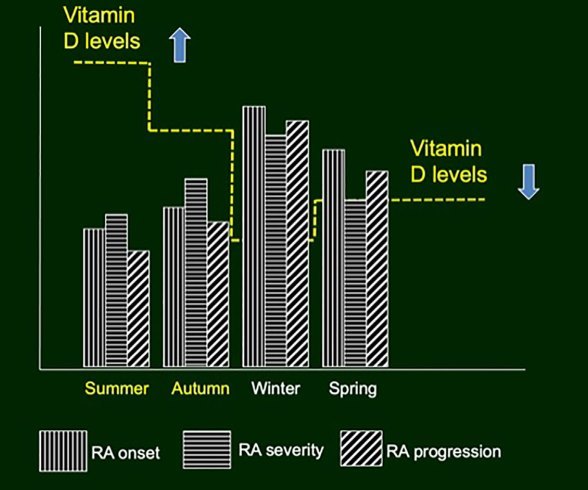Rheumatoid Arthritis worse in winter (low Vitamin D)
Influence of Seasonal Vitamin D Changes on Clinical Manifestations of Rheumatoid Arthritis and Systemic Sclerosis
Front. Immunol., 29 June 2021 | https://doi.org/10.3389/fimmu.2021.683665
Maurizio Cutolo1*†, Stefano Soldano1†, Alberto Sulli1, Vanessa Smith2,3,4 and Emanuele Gotelli1
1Laboratory of Experimental Rheumatology and Academic Division of Clinical Rheumatology, Department of Internal Medicine and Specialties (DIMI), University of Genova, IRCCS San Martino Polyclinic, Genova, Italy
2Department of Rheumatology, Ghent University Hospital, Ghent, Belgium
3Department of Internal Medicine, Ghent University Hospital, Ghent, Belgium
4Unit for Molecular Immunology and Inflammation, Vlaams Instituut voor Biotechnologie (VIB) Inflammation Research Center (IRC), Ghent, Belgium

📄 Download the PDF from VitaminDWiki
Vitamin D [1,25(OH)2D—calcitriol] is basically a steroid hormone with pleiotropic biologic effects, and its impact on the regulation of immune system may influence several clinical conditions. Calcidiol (25OHD), as precursor of calcitriol, derives, for the most part (80%), from cutaneous cholesterol (7-dehydrocholesterol) under the action of UV-B (sunlight). Consequently, serum concentrations fluctuate during the year following the circannual rhythm of sun exposition. We will update about the available evidence regarding the complex influence of seasonal vitamin D changes on two different chronic connective tissue diseases, namely rheumatoid arthritis (RA) and systemic sclerosis (SSc). Notably, RA is an emblematic model of autoimmune disease with prevalent joint inflammatory features, while SSc is mainly an autoimmune progressive pro-fibrotic disease. However, in both conditions, low serum concentrations of 25OHD are involved in the pathogenesis of the diseases, and emerging data report their impact on clinical manifestations.
